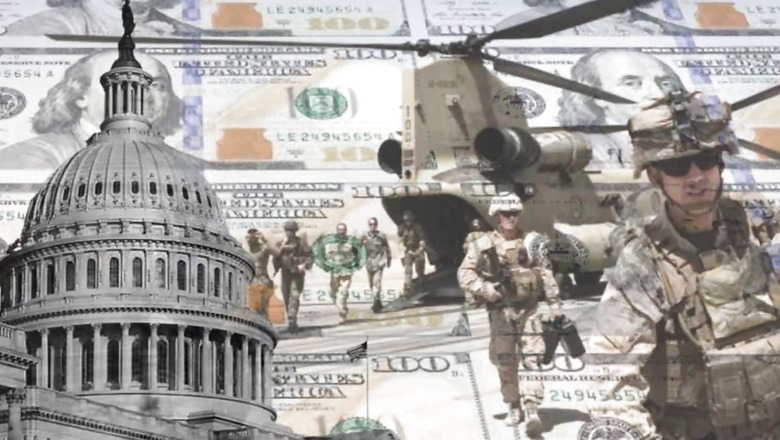
views
The United States is making a grand spectacle of itself by putting out its $31-trillion debt for the world to see and take note of. At the root of the problem is the debt ceiling, one that has been breached, and needs to be raised before the US Treasury runs out of cash. And the deadline to avert this possible default has been revised to June 5, from the earlier date of June 1. The problem, however, is not so much that the debt ceiling cannot be raised or that the $31.4 trillion debt is weighing down too heavily on the US as a debt-ridden nation. The problem is that the USA is dilly-dallying through a self-inflicted crisis which is exposing the hollowness of its biggest strength — the supremacy of the dollar.
Only a week is left until the USA defaults. The situation may seem dire. The effect of such a default would be felt globally and would burn a giant hole in the USA’s reputation as a superpower, even end it as it is. The Republicans and Democrats know what a default means. The US will fail to service its bills, run federal schemes or pay salaries to government employees or army personnel. The country would come to a standstill. Even aid-dependent Ukraine has a stake in this madness. The result would be an economic bloodbath. The stock markets would crash. First in the US, then in the rest of the world. A US market crash would deal a deadly blow to the global economy. The chaos would be out of everyone’s hands.
But instead of finding a solution, they are busy fighting, even when they are dangerously close to an economic and financial disaster of their own making. But while you may see panic spreading in the media and even in financial markets, the politicians are more interested in taking this to the last minute until either side blinks. The Republicans want to take this opportunity to make President Biden make big federal budget cuts ahead of the 2024 election, but the Democrats want no such compromise— only a clean one-sided deal to approve a raised debt limit in the Congress. The question is why are they killing so much time to work out something that is clearly in national interest? But before that, one must understand the USA’s national debt.
The USA’s inflating debt started with war and continues to be a consequence of war. Following the Revolutionary War (1775-83) against the British, Alexander Hamilton, a founding father and the first Treasurer, called for the debt incurred by the states during the war to be assumed by the US government. The idea was to provide security against any foreign attack by a competing empire. He was aiming for the European empires, like the British, Spanish and French. He wanted to make it easier to mobilise resources during a war. Hamilton described meeting all financial commitments on time, or averting a default as a matter of national honour. A century later, in 1917, when Europe’s trenches were littered with bodies, the Congress introduced a debt ceiling to share some of its fiscal authority with the Treasury and make it easier to raise cash until the prescribed limit was breached. The result was the issuance of massive war bonds which set the American industrial base in motion like never before and turned the tide of the first world war in favour of the allies. This was when the dollar dethroned the British pound as the dominant currency and the rest is history.
There’s a reason why the USA is continuously at war. Its military-industrial complex is one-of-its-kind and the strongest lobbying group. Trillions are spent on war alone. It’s not just welfare spending, but the Iraq war, Afghan war and other miscellaneous expeditions which over decades have contributed to the rising debt limit. The annual American defence budget has no parallel. It is ready to breach the $850 billion dollar mark, nearing a trillion. China, with $225 billion, is a distant second. The only thing the US is trying to match up to is its debt ceiling, not a foreign power.
Ever since the Nixon shock, the dollar, which had then become a fiat currency— one that is not backed by gold or silver, but by the might of the US government (and military)— would then give an incredible power to Americans, which is to spend more than they earn and spend, spend and spend (print, print and print). This ability is enforced by the world and that’s why things work out for it every time.
Nations around the world buy US dollar bonds from the American government. More than $7 trillion in US dollar bonds are owned by non-G7 countries. They see these bonds as a safe and lucrative investment. Post-default, the USA’s credit-rating would be downgraded, the dollar would nosedive, bleeding out their wealth in the process. If they decide to do away with the dollar altogether, the effect would be catastrophic for the United States. Needless to say, inflation would skyrocket and every US citizen would pay for such a collapse.
This, however, is theoretical. The worst-case scenario. The debt ceiling has been raised 78 times since 1960. It does not help that the Republicans have taken the Senate and are blocking the smooth passage of a new raise for the Treasury, but in reality, the US is likely to not default anytime soon. Firstly, because that date would simply be extended until a deal is reached. It is likely that the Treasury could keep going as far as August. After all, the US hit the debt ceiling in January this year and has been running on “extraordinary measures” or “accounting gimmicks” — euphemisms for cooking the books. Secondly, the Biden administration and the Treasury would do everything to avert a default. President Biden’s options include hacks like exploiting a legal loophole and “minting a trillion dollar coin”, challenging the constitutionality of the debt ceiling itself or invoking the 145-year-old 14th Amendment to empower himself to bypass the Congress.
It does not mean, though, that if a default is indeed averted, all will be well for the US economy. In 2011, a similar situation occurred where the US was just days from a “default”. At the time, the debt ceiling was half of what it is today. S&P had downgraded the USA’s credit-rating for the first time. The impact was strong, but short-lived as the US dollar soon recovered. This was because the government issued a good load of dollar bonds, which were readily embraced by global investors, including foreign governments. But at the time, the dollar had no alternatives and no one to formidably question its supremacy. That is changing as of 2023. The deployment of extensive sanctions on Russia amid its war on Ukraine— its complete exclusion from the global dollar-based financial systems and the seizure of its assets, including forex reserves— has made the world notice the perils of falling foul of the Americans. China, India and Brazil, among others, are taking notes, each weighing the threat in their own contexts. The possibility of an American default gives them further reason to diversify.
Who wouldn’t want to be insulated from such a threat to financial sovereignty? The question on the rise today is whether it is worth being widely exposed to the dollar. There is talk of alternative reserve currencies. The Euro and the Yen already occupy mind and market share and there’s no denying that the Yuan is getting there. Independent digital currencies also present a new challenge to the dollar. Can the US forever take for granted its unique ability to “keep printing” and spend more than it earns, and off-loading dollar bonds on global finances whenever it is under stress?
The US sees the convergence of China and Russia as its biggest threat and to meet the geopolitical challenges emerging from this shifting world order, any US President would do everything in their power to raise the debt limit, not reduce the country’s debt. The game is rigged and it only works as long as alternatives to the dollar remain elusive.



















Comments
0 comment